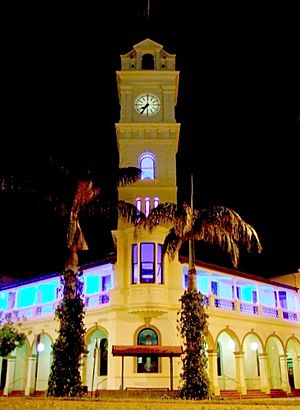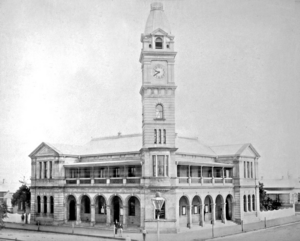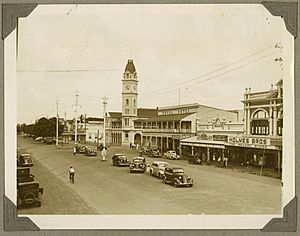Bundaberg Post Office facts for kids
Quick facts for kids Bundaberg Post Office |
|
|---|---|

Bundaberg Post Office at night, 2006
|
|
| Location | 155a Bourbong Street, Bundaberg Central, Bundaberg, Bundaberg Region, Queensland, Australia |
| Official name: Bundaberg Post Office | |
| Type | Listed place (Historic) |
| Designated | 8 November 2011 |
| Reference no. | 106125 |
| Lua error in Module:Location_map at line 420: attempt to index field 'wikibase' (a nil value). | |
The Bundaberg Post Office is a special old building in Bundaberg Central, Bundaberg, Queensland, Australia. It is located on Bourbong Street and is known for its beautiful design. This important building was added to the Australian Commonwealth Heritage List on 8 November 2011. It has served the community for many years, helping people send letters and connect with others.
Contents
History of the Bundaberg Post Office
The Bundaberg Post Office was built between 1890 and 1891. It was designed by Charles McLay, who worked for the Queensland Colonial Architect's office. The building was meant to replace an older, smaller post office from around 1879.
Early Years and Changes
When it first opened, the building also had offices for the Crown Lands Department. In 1893, the French Cable Co. started using the first floor. They exchanged messages through an undersea cable that connected to Vancouver via New Caledonia.
In 1907, the Lands Office on the first floor was changed into living quarters for the postmaster. Later, in the mid-1950s, more updates were made. These included adding the tower clock and new clock faces. A garage, bicycle shelter, and toilet block were also built.
Around 1998, the building had a major makeover. The public areas were updated, and new offices were created. They also added a ramp for disabled access and automatic glass doors at the main entrance. Some older parts of the building, like sunhoods and roof decorations, were removed over time.
What the Bundaberg Post Office Looks Like
The Bundaberg Post Office is at 155a Bourbong Street, right on the corner of Barolin Street. It stands out in the busy center of Bundaberg. Nearby, you can see other old buildings with similar designs, like the St Joseph's Catholic Cathedral.
Building Shape and Style
The main building has an L-shape and is two stories tall. A tall clock tower stands at the corner, facing the street diagonally. This tower is a very noticeable part of the building. There are also single-story sections on both the north and west sides.
The building's style is called Italianate. This means it looks like old Italian buildings, often with arches and decorative details. The front of the building has a double-height arcade, which is like a covered walkway with columns. The columns on the ground floor are square, and the upper level has a verandah with fancy cast iron columns and railings.
The Clock Tower
The corner clock tower is very impressive. It has several levels with different types of windows and decorations. At the top, there's a mansard roof (a roof with four sloping sides) with a flagpole and a weathervane. The main roof of the building is L-shaped with corrugated galvanised iron.
Inside and Out
The building is made of strong brick walls with stone foundations. The floors and roof are made of timber. The outside walls are covered in a special finish that makes them look like stone blocks. Inside, many walls are plastered brick.
Over the years, some parts of the building have changed. For example, the original main entrance doors were replaced. Inside, some of the original features have been updated as the building's use changed. However, much of the original design and structure are still there.
Why the Bundaberg Post Office is Important
The Bundaberg Post Office was added to the Australian Commonwealth Heritage List on 8 November 2011. This means it is a very important building that needs to be protected.
Its Place in History
The post office was built in 1891, when Bundaberg was growing fast. The city was important for sugar, mining, and farming. The large size and grand design of the post office show how successful and confident Bundaberg was at that time. It was a major center for postal services and other government work.
A Special Design
The Bundaberg Post Office is a great example of a "second generation" post office built between 1870 and 1929. These buildings often combined postal services, telegraph offices, and living quarters for the postmaster. This building also included government offices.
It shows the Italianate Style well, which was popular for important public buildings. The design, with its angled corner tower and two equally important street fronts, was quite unique for its time. It was designed by Charles McLay, working under George Connolly, the Queensland Colonial Architect.
Beautiful and Unique
The building is large and has impressive fronts facing two main streets. Its six-level clock tower makes it a landmark that stands out. The way the corner tower is placed diagonally to the streets is very clever. It makes the building look interesting from all directions. It's part of an important area with other historic buildings like the former Commercial Bank and the Bundaberg War Memorial.
A Community Landmark
The Bundaberg Post Office is important because it has been a central part of the city's growth. It's a visual symbol for the local community and has provided postal services for over 120 years. It connects people to the city's past and its ongoing life.
Images for kids






